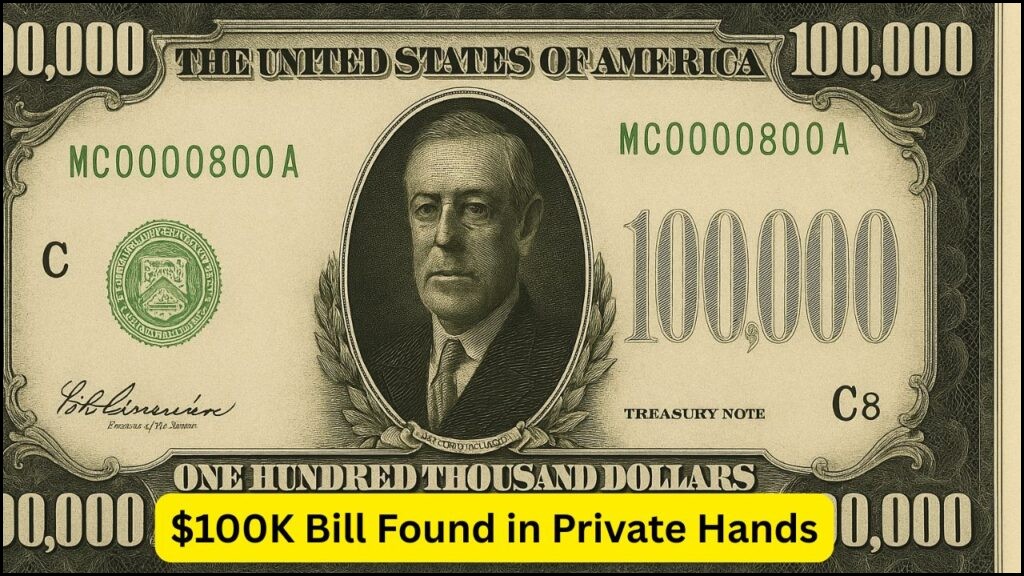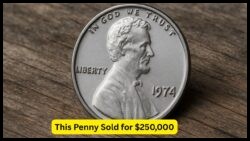$100000 Treasury Note – In the fascinating world of rare currency collecting, few notes command the awe and historical significance of the 1934 $100,000 Gold Certificate. Originally created as an internal financial tool by the U.S. government, this ultra-high denomination note was never intended to be circulated among the public. Today, the fact that one of these rare bills has ended up in private hands has sparked widespread intrigue, controversy, and excitement in both numismatic circles and the general public. These legendary notes, bearing the image of Woodrow Wilson and printed in vibrant gold ink, were part of an exclusive run authorized during the Great Depression era. Their purpose? To facilitate high-level transfers between Federal Reserve Banks. They were once locked away in vaults and handled only by top government officials. So how did one end up outside the system? Let’s explore this monetary mystery and its immense value today.
What Was the Purpose of the $100,000 Treasury Note in 1934?
Created during a time of economic instability, the $100,000 bill was never meant to be used like regular currency. Instead, it served a technical role behind closed doors.
Key Functions of the 1934 $100,000 Note:
- Used only for official transactions between Federal Reserve Banks
- Printed under the Series 1934 Gold Certificate classification
- Backed by gold held by the U.S. Treasury
- Not circulated or distributed to banks, businesses, or individuals
- Required special authorization for movement or destruction
Unique Features of the 1934 $100,000 Gold Certificate
Unlike everyday currency, this note had unique characteristics to prevent misuse and track its limited use. It also stood apart visually.
| Feature | Description |
|---|---|
| Denomination | $100,000 (highest U.S. currency ever printed) |
| Portrait | President Woodrow Wilson |
| Color | Gold seal with gold-colored serial numbers |
| Material | Standard paper blend with reinforced security |
| Circulation Status | Never released to the public |
| Series Year | 1934 |
| Issuing Body | U.S. Treasury / Federal Reserve Banks |
| Use | Inter-bank gold certificate for large transactions |
How Did One End Up in Private Hands?
It is technically illegal to own a 1934 $100,000 bill as a private citizen. However, one such note has surfaced and is now held in a private collection—most likely acquired under unusual or gray-market circumstances.
Possible Scenarios:
- Mishandled destruction process post-decommissioning
- Slipped through the cracks during government audits
- Illegally retained by a former official or employee
- Leaked into the numismatic market before rules tightened
While the exact origins remain speculative, the private ownership of one such note has sparked ethical and legal questions—and significant interest.
Market Value and Legal Gray Area
Since this note was never issued for public use, technically it cannot be legally bought or sold. But in the collector’s world, ownership of such a note—even if unofficial—is a bragging right worth millions.
| Detail | Current Estimate |
|---|---|
| Face Value | $100,000 |
| Legal Market Value | $0 (not legal tender for public use) |
| Private Collector Value | $6 million to $12 million (black/gray market) |
| Auction Possibility | Cannot be auctioned by major U.S. houses |
| Legal Risks | Seizure by U.S. Treasury if discovered |
| Historical Value | Immeasurable – linked to Depression-era history |
Why It Remains One of the Most Fascinating Currency Pieces Ever
This note is more than just paper—it’s a relic from a financially turbulent era in U.S. history. It symbolizes:
- The trust the government placed in its monetary mechanisms
- The unprecedented financial strategies of the New Deal
- The secrecy and control surrounding high-level financial systems
- The lingering mystique of government-restricted items
Other Ultra-Rare High-Denomination Notes
There are other large-denomination notes from the early 1900s, but none match the rarity and restrictions of the $100,000 Gold Certificate.
| Denomination | Year | Status | Value Estimate |
|---|---|---|---|
| $500 | 1928/1934 | Discontinued, collectible | $2,000–$5,000 |
| $1,000 | 1934 | Discontinued, collectible | $3,000–$10,000 |
| $5,000 | 1934 | Very rare, collectible | $15,000–$100,000 |
| $10,000 | 1934 | Extremely rare | $50,000–$250,000 |
| $100,000 | 1934 | Not legal for public use | $6M–$12M (informal) |
The existence of a $100,000 bill in private hands proves one thing—no matter how tight the system, history has a way of slipping through. This single note, now locked away by a private collector, is a whisper of Depression-era America and a monument to its economic survival strategies. For numismatists and history buffs alike, it remains a symbol of forbidden wealth, government secrecy, and incredible financial curiosity.
FAQs
Q1. Was the $100,000 bill ever used by the public?
No, it was strictly used for internal transactions between Federal Reserve Banks and never circulated publicly.
Q2. Is it legal to own a 1934 $100,000 bill?
Technically, no. These notes were never issued for public use and are considered illegal to privately possess.
Q3. Who is featured on the 1934 $100,000 bill?
President Woodrow Wilson is featured on this rare note.
Q4. How many of these bills were printed?
Approximately 42,000 were printed, all for inter-bank transfers.
Q5. How did one end up in private hands?
The exact path is unknown, but it likely avoided destruction or was acquired through unofficial means.






